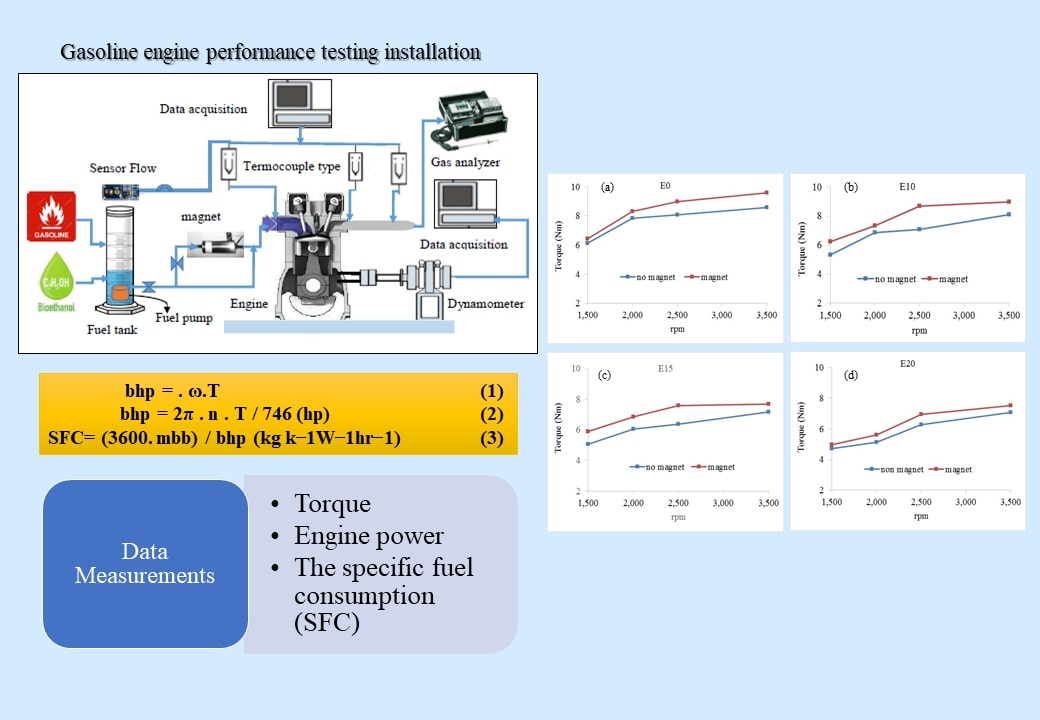Experimental studies to improve IC engine performance through magnetization of fuel mixture of gasoline and bioethanol
DOI:
https://doi.org/10.55674/snrujst.v14i2.246760Keywords:
Magnet, Bioethanol, Torque, Power, SFCAbstract
Research related to the magnetization of fossil fuels is currently believed to be able to improve the quality of combustion due to the cluster decluster effect on the fuel. Fossil fuels are finite and non-renewable. Meanwhile, non-fossil energy, especially bioethanol, despite having more environmentally friendly exhaust gas emissions and higher octane rating than gasoline, has a lower calorific value than gasoline. To overcome this deficiency, the fuel magnetization of a mixture of gasoline and bioethanol is carried out. The fuel is used in 4 stroke injection motorcycles. Furthermore, the performance of the 4-stroke injection motorcycle was observed. the fuel mixture without magnetization was used as a control variable. The intensity of the electromagnetic field used is less than 2,000 Gauss, this is different from previous analysts. As a result, the magnetized motorcycle experienced an increase in torque of 4.48 – 7.30%, power of
4 – 9.90%, and a decrease in SFC of 6 – 9.20%.
References
X. Wang, Z. Chen, J. Ni, S. Liu, H. Zhou, The effects of hydrous ethanol gasoline on combustion and emission characteristics of a port injection gasoline engine, Case Stud. Therm. Eng. 6 (2015) 147 – 154.
S. Corsetti, F.M. Zehentbauer, D. Mcgloin, J. Kiefer, Characterization of gasoline/ ethanol blends by infrared and excess infrared spectroscopy, Fuel. 141 (2015) 136 – 42.
A.S. Faris, K. Saadi, N. Jamal, R. Isse, M. Abed, Z. Fouad, A. Kazim, N. Reheem, A. Chaloob, M. Hazim, H. Jasim, J. Sadeq, A. Salim, A. Abas, Effects of magnetic field on fuel consumption and exhaust emissions in two-stroke engine, Energy Procedia. 18 (2012) 327 – 338.
R.C. Costa, J.R. Sodré, Compression ratio effects on an ethanol/gasoline fuelled engine performance, Appl. Therm. Eng. 31 (2011) 278 – 283.
R. Monasari, S. Abikusna, B. Sugiarto, B. Ajiseno, Analysis of emission gas and fuel consumption on SI engine fueled with low-grade bioethanol and oxygenated cycloheptanol additive, IOP Conf. Ser. Earth Environ. Sci. 105(1) (2018) 012058.
V. Ugare, A. Dhoble, S. Lutade, K. Mudafale, Performance of internal combustion (CI) engine under the influence of stong permanent magnetic field, IOSR J. Mech. Civ. Eng. 3 (2014) 11 – 17.
K. Chaware, Review on effect of fuel magnetism by varying intensity on performance and emission of single cylinder four stroke diesel engine, Intl. J. Eng. Res. 3 (2015) 174 – 178.
A.G. Mariaca, R.M. Castaño, Anhydrous bioethanol gasoline blends at high altitude above sea level in a SI engine, Biofuels. 4 (2018) 1759 – 1769.
T.H. Nufus, S.L. Kusumastuti, A. Ulfiana, N. Hidayati, E. Ridwan, A. Sulistyowati, M.H. Tullah, I. Nuriskasari, C.S. Abadi,
Two wheeled vehicles e20 fuel magnetization study on exhaust gas emissions, IJMPERD. 10 (2020) 201 – 212.
L. Zhao, X. Wang, D. Wang, X. Su, Investigation of the effects of lean mixtures on combustion and particulate emissions in a DISI engine fueled with bioethanol- gasoline blends, Fuel. 260 (2020) 1 – 7.
Y.A. Cengel, M.A. Boles, Thermodinamika an engineering approach, Fifth Ed., Graw- Hill, New York, 2006
G. Gabina, O. Basurko, E.Notti, A. Sala, S. Aldekoa, M. Clemente, Z. Uriondo, "Energy efficiency in fishing: are magneticdevices useful for use in fishing vessels?",Appl. Therm. Eng. 94 (2016) 670 – 678.
M. Gad, A. Farrang, Effect of fuel magnetism on industrial oil burner performance burning waste cooking oil,
Intl. J. Eng. Tech. 16 (2016) 25 – 37.
C. Chen, W. Lee, J. Mwangi, L. Wang, J. Lu, Impact of magnetic tube on pollutant emissions from the diesel engine, AAQR.
(2017) 1097 – 1104.
A. Khedvan, V. Gaikwad, Review on
effect of magnetic field on hydrocarbon refrigerant in vapour compression cycle, Intl. J. Sci. Eng. Tech. Res. 4 (2015) 1374 – 1378.
J.O. Igbokwe, O.C. Nwufo, C.F. Nwaiwu, C. Ononogbo, K.M.D Ezeji, Performance characteristics of a single cylinder spark ignition engine fuelled with ethanol–petrol blends at constant engine speed, Biofuels. 12 (2016) 132 – 144.

Downloads
Published
How to Cite
Issue
Section
License
Copyright (c) 2022 SNRU Journal of Science and Technology

This work is licensed under a Creative Commons Attribution-NonCommercial-NoDerivatives 4.0 International License.








